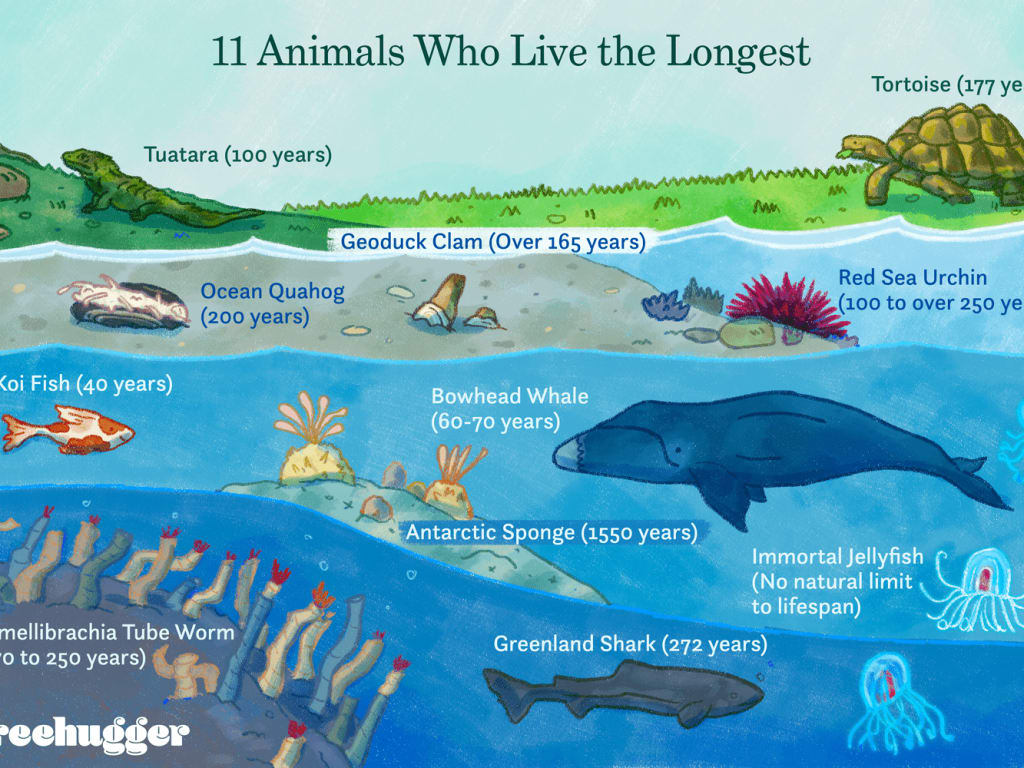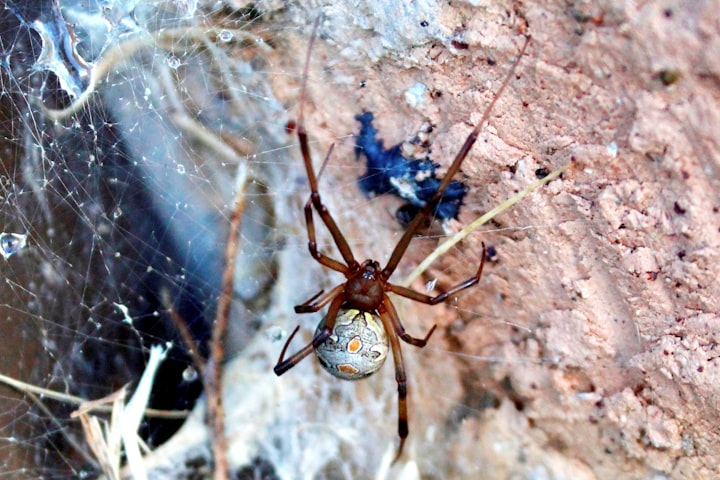The longest-living creatures on Earth
The collective of animals flaunts some unimaginably long life expectancies that far surpass the normal human's. While people might have a "flat out limit" of 150 years, this is only a squint of an eye contrasted and the hundreds of years and centuries that a few creatures live through; and a few creatures can even stop or opposite the maturing system inside and out.

10. Hydra: Also Potentially Immortal
HydraHydra is a gathering of little spineless creatures with delicate bodies that look a bit like jellyfish. Like Turritopsis dohrnii, hydras additionally can possibly live until the end of time. Hydras don't give indications of disintegrating with age, Live Science recently detailed. These spineless creatures are generally comprised of foundational microorganisms, which consistently recover through duplication or cloning. Hydras don't live perpetually under normal conditions on account of dangers like hunters and illness, yet without these outside dangers, they could be eternal.
The Hydra was a multi-headed beast that grew two additional heads for each one that it lost. For reasons unknown, the genuine creature named after this legendary monster might be considerably more relentless. Another investigation discovers that hydra — spindly, freshwater polyps — can live apparently always, without water.
9. Turritopsis Dohrinii: Potentially Immortal
Turritopsis dohrnii are called interminable jellyfish since they might conceivably live until the end of time. Jellyfish start life as hatchlings, prior to securing themselves on the ocean bottom and changing into polyps. These polyps then, at that point produce free-swimming medusas or jellyfish. Develop Turritopsis dohrnii are uncommon in that they can turn around into polyps in case they are genuinely harmed or starving, as per the American Museum of Natural History, and afterward return to their jellyfish state.
The jellyfish, which are local to the Mediterranean Sea, can rehash this accomplishment of switching their life cycle on different occasions and subsequently may never pass on of advanced age under the right conditions, as per the Natural History Museum in London. Turritopsis dohrnii are little — under 0.2 inches (4.5 millimeters) across — and are eaten by different creatures like fish or may pass on by different means, consequently keeping them from really accomplishing eternality.
8. Glass Sponge: 10,000 Years Old
Wipes are comprised of settlements of creatures, like corals, and can likewise live for millennia. Glass wipes are among the longest-living wipes on Earth. Individuals from this gathering are regularly found in the profound sea and have skeletons that take after glass, consequently their name, as per NOAA. A recent report distributed in the diary Chemical Geology assessed that a glass wipe having a place with the animal types Monorhaphis chuni was around 11,000 years of age. Other wipe species might have the option to live much more.
Glass wipes have skeletons made of silica, which is a similar material used to make glass, yet glass wipes are not glass, in essence. ... Glass wipes, or hexactinellids, have a place with the phylum Porifera. These creatures are normal just in the profound sea. Their tissues contain glass-like primary particles made of silica.
7. Dark Coral: 4,000+ Years Old
Corals look like bright, submerged shakes and plants, however, they are really comprised of the exoskeletons of spineless creatures called polyps. These polyps ceaselessly increase and supplant themselves by making a hereditarily indistinguishable duplicate, which over the long haul causes the coral exoskeleton design to become greater and greater. Corals are accordingly comprised of numerous indistinguishable life forms as opposed to being a solitary living being, similar to Greenland sharks or sea quahog shellfishes, so a coral's life expectancy is, even more, a collaboration.
Corals can live for many years or more, yet profound water dark corals (Leiopathes sp.) are among the longest-living corals. Dark coral examples found off the shoreline of Hawaii have been estimated to be 4,265 years of age, Live Science recently detailed.
6. Sea Quahog Clam: 500+ Years Old
Sea quahog shellfishes (Arctica islandica) possess the North Atlantic Ocean. This saltwater species can live significantly more than the other bivalve in this rundown, the freshwater pearl mussels. One sea quahog shellfish found off the shore of Iceland in 2006 was 507 years of age, as per National Museum Wales in the U.K. The antiquated mollusk was nicknamed Ming as it was brought into the world in 1499 when the Ming tradition controlled China (from 1368 to 1644).
How long can crude mollusks be left at room temperature? Microorganisms develop quickly at temperatures between 40 °F and 140 °F; mollusks ought to be disposed of whenever left out for over 2 hours at room temperature and consistently dispose of in case shellfishes are at this point not alive. Mollusks are alive when you get them and they need air, which is the reason most fishmongers punch holes in the plastic packs that convey them. ... Then, at that point, not long prior to cooking the shellfishes, scour them well with a brush under cool running water until the shells feel clean and sand-free. Although Icelandic waters appear to give the best conditions to outrageous life span, mollusks with lifetimes well more than 200 years have been discovered both in the Irish Sea and the North Sea
5. Tubeworm: 300+ Years Old
Tubeworms live around aqueous vents along the Mid-Ocean Ridge in the Eastern Pacific Ocean. They can grow up to two meters in length and ten centimeters in distance across. Tubeworms never leave their cylinders, which are made of a hard material
Tubeworms are spineless creatures that have long life expectancies vulnerable to, stable climate of the remote ocean. A recent report distributed in the diary The Science of Nature found that Escarpia laminate, a type of tubeworm living on the sea depths in the Gulf of Mexico, consistently satisfies 200 years, and a few examples make due for over 300 years. Tubeworms have a low passing rate with not many normal dangers, like an absence of hunters, which has assisted them with developing to have such long life expectancies.
Riftia pachyptila, regularly known as the goliath tubeworm, is a marine invertebrate in the phylum Annelida (once in the past gathered in phylum Pogonophora and Vestimentifera) identified with tubeworms generally found in the intertidal and pelagic zones.
4. Greenland Shark: 272+ Years Old
Greenland sharks (Somniosus microcephalus) live somewhere down in the Arctic and North Atlantic seas. They can develop to be 24 feet (7.3 meters) long and have an eating regimen that incorporates an assortment of different creatures, including fish and marine warm-blooded animals like seals, as per the St. Lawrence Shark Observatory in Canada.
The tissue of the Greenland shark is harmful in light of the presence of high groupings of trimethylamine oxide (TMAO). On the off chance that the meat is eaten without pretreatment, the ingested TMAO is utilized into trimethylamine, which can deliver outcomes like outrageous tipsiness. ... It is viewed as a delicacy in Iceland
A 2016 investigation of Greenland shark eye tissue, distributed in the diary Science, assessed that these sharks can have a most extreme life expectancy of somewhere around 272 years. The greatest shark in that review was assessed to be around 392 years of age, and the scientists proposed that the sharks might actually have been however much 512 years of age, Live Science recently detailed. The age gauges accompanied a level of vulnerability, however, even the most reduced gauge of 272 years actually makes these sharks the longest-living vertebrates on Earth.
3. Freshwater Pearl Mussel: 250+ Years Old
Freshwater pearl mussels (margaritifera) are bivalves that channel particles of food from the water. They primarily live in waterways and streams and can be found in Europe and North America, including the U.S. what's more, Canada. The most seasoned realized freshwater pearl mussel was 280 years of age, as per the World Wildlife Fund (WWF). These spineless creatures have long life expectancies on account of their limited capacity to burn calories.
Grown-up Pearl Mussels live with the lower part of their shells covered in the waterway bed, so it is significant that the stream bed is comprised of a decent combination of little and medium-sized stones to assist with keeping the mussel set up
Freshwater pearl mussels are an imperiled species. Their populace is declining because of an assortment of human-related variables, including harm and changes to the stream territories they rely upon, as per the International Union for Conservation of Nature (IUCN).
2. Rougheye Rockfish: 200+ Years Old
Generally, rockfish (Sebastes Aleutians) is one of the longest-living fish and has the greatest life expectancy of something like 205 years, as per the Washington Department of Fish and Wildlife. These pink or caramel fish live in the Pacific Ocean from California to Japan. They grow up to 38 inches (97 centimeters) in length and eat different creatures like shrimp and more modest fish, as indicated by the Committee on the Status of Endangered Wildlife in Canada (COSEWIC), an autonomous warning board that surveys the situation with species undermined with eradication in Canada.
Roughly Rockfish is an excellent eating fish with white, moderately flavored flesh that is tender but holds together well with any cooking method. It's easy to eliminate all the bones, and on the plate it separates easily into large flakes.
1. Bowhead Whale: Potentially 200+ Years Old
Bowhead whales (Balaena mysticetus) are the longest-living warm-blooded animals. The Arctic and subarctic whales' accurate life expectancy is obscure, however, stone spear tips found in some gathered people demonstrate that they easily live more than 100 years, and may live over 200 years, as indicated by the National Oceanic and Atmospheric Administration (NOAA).
The whales have changes in a quality called ERCC1, which is engaged with fixing harmed DNA, that might assist with shielding the whales from malignancy, an expected reason for death. Moreover, another quality, called PCNA, has a part that has been copied. This quality is engaged with cell development and fix, and the duplication could slow maturing, Live Science recently detailed.






Comments
There are no comments for this story
Be the first to respond and start the conversation.